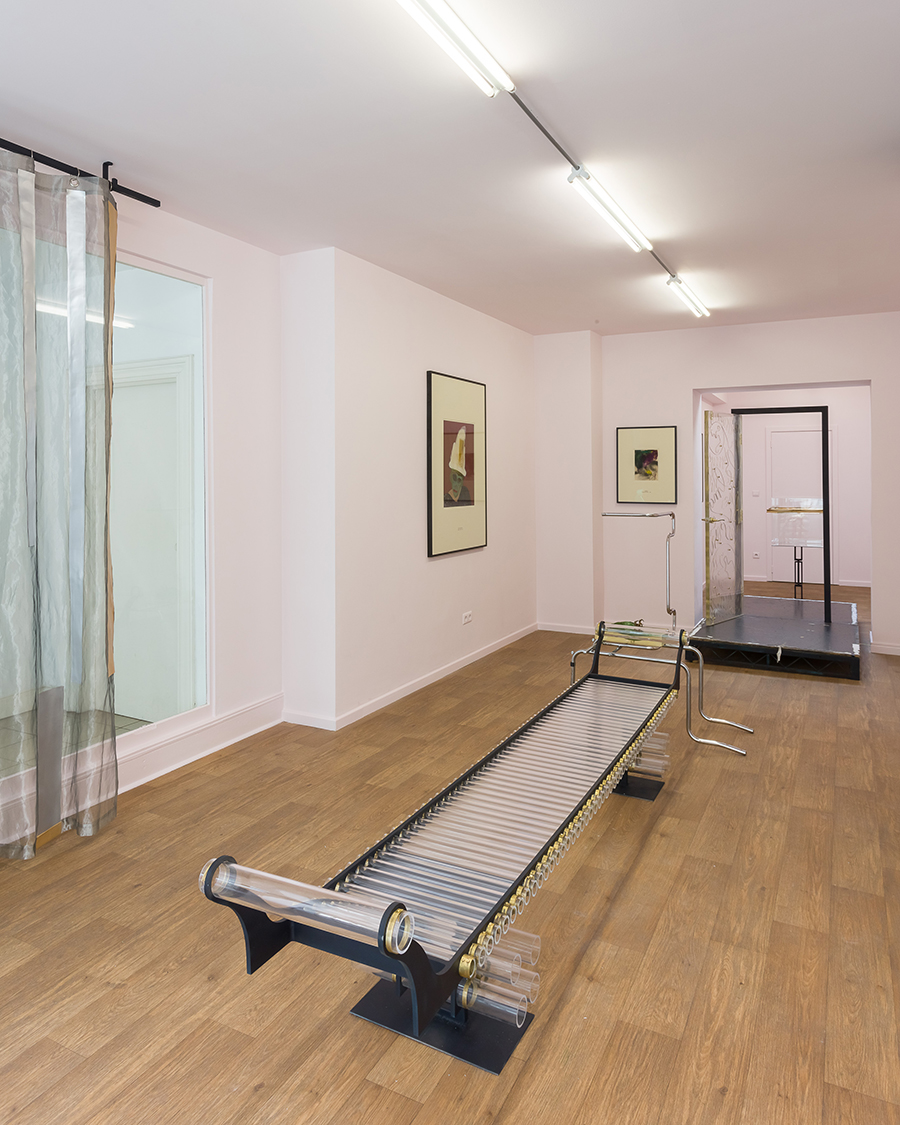Than Hussein Clark’s Exquisite Dramaturgy of 1930s Actress and Artist Selma Vaz Dias
At Damien & The Love Guru, Brussels, Clark queers the historical record about a past cultural figure
At Damien & The Love Guru, Brussels, Clark queers the historical record about a past cultural figure

Than Hussein Clark has cast actress and artist Selma Vaz Dias (1911–1977) in a lead role in one of his latest productions: the exhibition ‘The Paintings of Selma Vaz Dias’ and a musical theatre piece Chamber Music for Europe (Nonent for Selma Vaz Dias) (2019). In the former, Clark couples some of Vaz Dias’s paintings and works on paper from the 1960s and ’70s with his own sculptures (for example, Cancellation Telephone Table, all works by Clark 2019) and décor (such as Fractured Rothschild Curtain in the Manner of Eduardo Paolozzi), while his performance for nine members of Clark’s theatre troupe The Director’s Theatre Writer’s Theatre is based on Vaz Dias’s unpublished autobiography.

Born in Amsterdam to a Sephardic Portuguese family, Vaz Dias narrowly escaped Jewish persecution in the Netherlands when she moved in 1922 to London, where she enrolled in the Royal Academy for Dramatic Arts. By the late 1930s, she had established herself as a stage, television and film actress (with notable roles in films including Alfred Hitchcock’s 1938 film The Lady Vanishes). Author Jean Rhys credited her creative revival to Vaz Dias’s adaptation of her novel Good Morning, Midnight (1939) into a BBC radio play in 1949, which led to their ongoing friendship.
With permission from Vaz Dias’s estate, Clark selected a dozen or so drawings and paintings from an inventory of around 270 works. Some of these have been tastefully matted and framed, while others are supported by structures made by Clark. Take Guerlain Vitrine A for ‘Jewish Bureaucrat’ and ‘The Unknown Telephone Intruder!’ by Selma Vaz Dias’, a bespoke gilt, mirror and Plexiglas vitrine containing a pair of slight sketches that Vaz Dias affixed to pages torn out of books, or Easel for ‘Old Clown’ by Selma Vaz Dias, a leggy steel stand propping up an expressive portrait of a clown. Vaz Dias’s portraits and animal paintings bear 19th-century themes like the circus, absinthe drinkers and housemaids. Judging from their styles, one surmises that Vaz Dias was an autodidact, and true experimentalist.

Clark is known for his elaborate mixed-media approach to plot-driven art and exhibitions. This approach simultaneously queers and acknowledges the extant queerness of the historical and cultural record. Figures such as filmmaker Rainer Werner Fassbinder, travel writer Bruce Chatwin, writer Jean Genet, and author and artist Edmund de Waal, have all featured as players or references. ‘The Paintings of Selma Vaz Dias’ appears to be the first time Clark spotlights a female protagonist in a show that seems to want to level the gendered, generational field between them.

I’ve only seen a teaser trailer for Clark’s dramatic rendition of Vaz Dias’s autobiography and Clark withholds almost all of the vivid details of her life from his exhibition, which guises Vaz Dias as a visual artist, if not especially one of her time. Clark does, however, include a graphite drawing that warns of her death in 1977. Self After Deep Ray Treatment—Tenerife (1976) is a haunted self-portrait by Vaz Dias, exhausted at the end of her life, her gaze fixed and features drained and shadowed by age, illness and treatment for cancer.
This drawing throws a funereal veil over Clark’s appealing design aesthetic, as well as the rest of Vaz Dias’s artistic production dating from a decade prior. His puff-pink walls, muted brass, jet enamel and reflective chrome design elements elegantly conjure an art deco fantasy of the actress’s dressing room, which materializes in Dressing Room Door for Selma Vaz Dias (2019). Installed like a portal, the door is made of resin engraved with Vaz Dias’s artist signature, peppered on both sides with brass-ringed peep holes and mounted on a fragment of a stage floor. With Vaz Dias’s dying self-portrait nearby, and her life so allusively portrayed, it’s easy to mistake it for a memorial.
Main Image: Than Hussein Clark, ‘The Paintings of Selma Vaz Dias’, 2019, installation view, Damien & The Love Guru, Brussels. Courtesy: the artist and Crèvecœur, Paris; photograph: Mark Blower
























